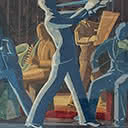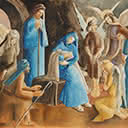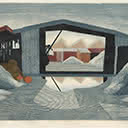Rhythm
36.5 x 115.5 cm
est. $1,500 - 2,500
By the mid-20th century, there was strong institutional fixation on emerging modernism and landscape art in New Zealand. It is therefore not surprising that Anna Lois White found herself marginalised by the art world throughout her career. Despite the knowledge that her work did not align to institutional tastes or trends, White pursued an individual tradition of classically-inspired symbolism integrating allegorical, art historical, biblical and political concerns.
In the 1940s, given the limited materials available during wartime, White had to abandon the large-scale compositions in oil that had dominated her output in the previous decade. She began working on a smaller scale, primarily in watercolour as can be seen in the works illustrated in this catalogue. A contemporary of White's, Marguerite Parson (neé Cotton) skillfully preserved moments of time in works of illustrative vibrancy bursting with life as illustrated in Rhythm. Born in Waipori in 1912 Cotton was the only daughter of four. She attended the Canterbury College of Art and in her second year, exhibited in the Academy of Fine Arts 1934 exhibition. 1935 saw Cotton gain a New Zealand Diploma of Fine Arts, being only one of two students to achieve this in the country.
Following her return to Dunedin she enrolled in the night classes being offered at King Edward Technical College. Alongside fellow pupils Anne Hamblett and Doris Lusk, Cotton received a first class pass in both Modelling and Life Drawing.
Early examples of her illustrative style can be seen in the University of Otago's Capping Book, adorning the 1939 cover. She also illustrated and wrote a children's colouring book, The Adventure Painting Book. In April 1940, at the onset of the second world war, Cotton wrote to both Major-General Duigan and the Minister of Defence Hon. F Jones, offering her services as a War Artist. Could you and your Defence Council arrange to send me to be New Zealand's pictorial historian of the day as far as illustrating war events is concerned? I have particularly good health and to live in a uniform in trenches or sleep in a sleeping bag and live on army rations would be an adventure. Women were not considered for the role of War Artist, however like many other female artists during this period, Cotton produced works reflecting the society of the time, such as her 1941 work NZ Industry in Wartime.





